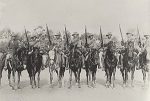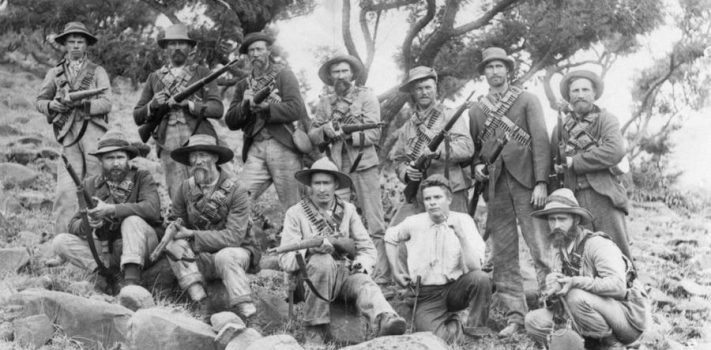This morning, as per usual, I am having more black beans and black bear soup for breakfast on a cold mountain in Montana, waiting for all h*ll to break loose. I prefer beef, but presently bear meat is all that I have.
The first few months of a collaspe may be the worst as the desperate and raiding gangs will be active. And then comes several years of famine. And the rest of the Four Horsemen. Today, I must decide on whether to get a range finder, or a box of 1,000 match-grade bullets for the old war horse: a glass-bedded, and deadly accurate Springfield M1903A3 rifle. I love old war horses. There is poetic justice involved when considering using Grandpa’s gun to get it done. I get to ponder this, and more until the coffee is gone.
The Boer and Their Battle Rifle
One of the reasons the Boer dominated the British in the Second Boer War is because they owned the latest in long-range precision rifles, the 7mm Mauser (7×57). These rifles were vastly superior to what the British had. [Most British troops carried low-velocity Martini-Henry sinle-shot .450 caliber rifles. A few had .303 Lee-Metfords, but even those were inferior to the 7mm Mauser.]
Along with their superior tactics, the bolt-action Loewe Mauser M1895 rifle gave them fire superiority over a vastly superior-in-number in force. Usually, there is a decisive advantage when deploying superior numbers, yet not always. The Boers were both exceptionaly-skilled and exceptionally well-motivated. Another reason is that they lived in remote South Africa. Raised on horses and shooting, they became excellent marksmen and horsemen, making them natural and trail-hardened calvary.
I got my first horse on my 9th birthday, rode a lot, and began hunting by age 10. If I could only be young again, I would strive to become a Boer. Now, I am only bore! They were some of the toughest and most cunning warriors ever! Special Operations, and Expeditionary Forces learned from this page in history, and has developed similar capability. It pays to pay attention.
The Boer were cavalry and guerrilla warrior combined. They were tactically dispersed, and strategically well-located. When they saw trouble coming — The Second Boer War — they prepared accordingly, and purchased as many of the Loewe Model 1895 7mm Mauser rifles as they could. Our American heritage is similar to the Boer. Even if it could only be a wall hanger, I would love to have an actual rifle that was owned and operated by the Boer. How sweet that would be.
 The Boers were the most tenacious minutemen ever! In the end, the Brits had to haul in other ‘colonials’, the Aussies (pictured), to round up the toughest Boer, known as the Bitter Enders. The Boer Wars 1 and 2, provide a fascinating history of heroic and tenacious underdogs versus the same empire our forefathers defeated. Yet the Boers were far more effective than our Revolutionary Army, and in the process redefined the warfare of that time. They proved that maneuver and long-range rifle fire to be vastly superior tactics, so employed, that a small number of defenders could defeat, or seriously challenge, a superpower that pitted their vast army against them.
The Boers were the most tenacious minutemen ever! In the end, the Brits had to haul in other ‘colonials’, the Aussies (pictured), to round up the toughest Boer, known as the Bitter Enders. The Boer Wars 1 and 2, provide a fascinating history of heroic and tenacious underdogs versus the same empire our forefathers defeated. Yet the Boers were far more effective than our Revolutionary Army, and in the process redefined the warfare of that time. They proved that maneuver and long-range rifle fire to be vastly superior tactics, so employed, that a small number of defenders could defeat, or seriously challenge, a superpower that pitted their vast army against them.
It required 240,000 British years of effort to subdue 20,000 Boers. In the end, they were celebrated all over Europe. They lost, yet in the eyes of many Europeans, they were heroes, because they disgraced the greedy bully, the British Empire. Perhaps, in actuality, they could be considered the victors, given that the independent nation-state of modern South Africa was eventually born. I feel more kinship with the Boer than the Amish. I’m genetically similar to the Amish folk, so my connection to the Dutch and Huguenot-bred Boers is decidedly a spiritual one. The Boer were Christians who fled Europe as did my Swiss ancestors, and for similar reasons. Their success can be in part attributed to a military advantage in the rifle they used, a flat shooting and deadly accurate cartridge, the 7x57mm Mauser.
Rule 308
We can have other rifles cartridges as our primary choice, yet we should have at least one rifle chambered in .308 Winchester. Ideally, it would be best to train with this cartridge, and become very acquainted with it. That said, I am indeed more accurate and will shoot more, flinch less, and can see the hit or miss and correct my fire, if I am shooting a lower recoil rifle that also has a flatter trajectory than .308.
Go with what you know and like best, but keep your options open, because without plenty of ammunition, a rifle is a worthless club. And because .308 Winchester is America’s second most popular and widely available cartridge, there will be lots of .308 Winchester out there when there is little else. If the stoutest recoiling .308 Win load is too much to handle (18 lbs), then one can always use a less potent loading that is a 7.62×51 NATO load that is a 147-150 grain projectile at 2,700 fps (feet per second). In a typical 8-pound rifle, it recoils with 15 lbs of energy instead of 18 pounds of recoil when full power and heavy-for-calber .308 Winchester ammunition is used.
What is the best long-range rifle for you?
Is it the one you got, or is it the one you would shoot more often? Or is it the rifle that you can afford to shoot? A scoped version of the same 7mm Mauser that the Boer used would be perfectly adequate today. The recoil is mild, the ammunition inexpensive, yet .223 Remington/5.56mm NATO is the most common ammunition, less expensive and available everywhere, and its recoil is negligible. The .223 (5.56 NATO) is ubiquitous because it has been in used by the military for more than 50 years.
Unfortunately, .223/5.56 has limitations that are not fully understood, or appreciated. The .223 is not the best choice for targets beyond 300 yards when using the least expensive and common 55 grain full metal jacket (FMJ) variety. Nor is it suitable for the quick and humane taking of deer-sized game. It can, however, be argued to be ideal for maneuver warfare, where most of the battles fought are within 300 yards, and more often inside of 150 yards, and where superior firepower is defined by an ability to carry more ammo than the opponent, and overwhelm them with an ability to put more rounds down range than the opposing side. There is an ongoing debate, yet that is why the military uses it.
The .223 is best suited to maneuver warfare by a military that uses tactics that uses ammunition that is light in weight, compact to carry, and that is good enough if engagements are at relatively short ranges. The downside is that it not a long-range cartridge, and it is not designed to quickly stop a fight even at close ranges, but tends to wound instead. Often the enemy can shoot back after being hit with .223. When using the equivalent of M193 5.56 NATO full metal jacket ammunition, five hits are sometimes needed to incapacitate the enemy. If using .223 for home defense, I would use expensive soft point ammunition and keep firing until they were down for good.
JWR Adds: The U.S. Army’s recent adoption of the SIG M5 rifle and M250 SAW — both chambered in 6.8×51mm illustrates that post-Afghan War military doctrine and logistics are finally catching up to reality. It will be several years before the active Army is fully equipped. And the Reserve and National Guard troops won’t all have them until the mid-to-late-2030s.]
If you’d like to use your AR-15 for medium long-range purposes, out to say 600 yards, use 69-grain bullets out of 16” barrels, or much better yet, use the 77-grain .223 bullets out of a 20 inch, or longer barrel to attain an adequately flat trajectory. The heavier bullets are necessary to compensate the effects of the wind that make it difficult to hit the target. The 55-grain bullet has a woefully low ballistic coefficent (B.C.) of only .160, therefore the wind easily blows the 55-grain .223 bullet too far off target to make it practical and competitive with other cartridges.
In addition, semi-automatic rifles that are typically used to fire .223 ammunition, lend themselves to a rate of fire than is not conducive to precision shooting, or making the shot count, first time, every time. As undisciplined, lazy, and predictable humans, if we are using a rifle that is used primarily for continuous fire, we are conditioned to operate that rifle in a way that tends not to make one shot count. It is just human nature.
Bolt action rifles tend to make us concentrate, and take the first shot more seriously, to “aim small, miss small” on the first, and perhaps, the only shot we’ll get. And the bolt action rifle usually has a scope mounted on it, and is designed to shoot with more precision at longer ranges. If fed the best ammunition, most bolt guns can shoot 1.5 MOA, or better, and that is plenty good enough for medium-range targets, as I define it, at 600 yards or less. After 600, the danger space, that is the space where the trajectory is adequately flat enough, that is, that the bullet flies no lower than 6 inches low, or 6 inches high as it passes through a 500 or 600 yard target. Some rifles shoot flatter than others, so what constitutes as the definition of medium long range is relative, and therefore can only be loosely defined.
Because .223 is found everywhere, it is inexpensive, and the AR-15 rifle is also found everywhere, and is inexpensive. In this country, the AR-15 platform is a must-have, however, it would only be my first choice if all my friends used it, and they do. And probably so does your friends. For a defense that in requires long ranges where opponents can not return with effective fire, I would also have a bolt action rifle in .308 Winchester. If I could not handle the recoil, and I would have a bolt action rifle in a flatter shooting cartridge that also is a mild recoiling rifle.
(To be concluded tomorrow, in Part 2.)










